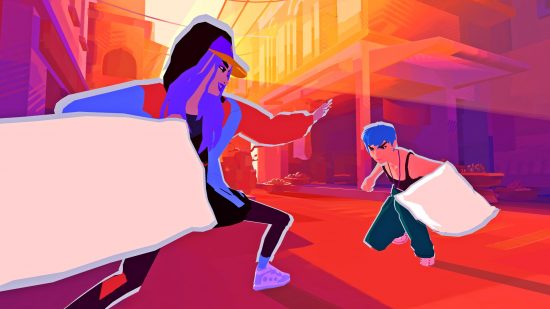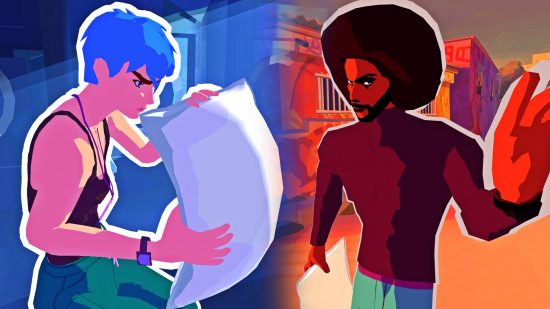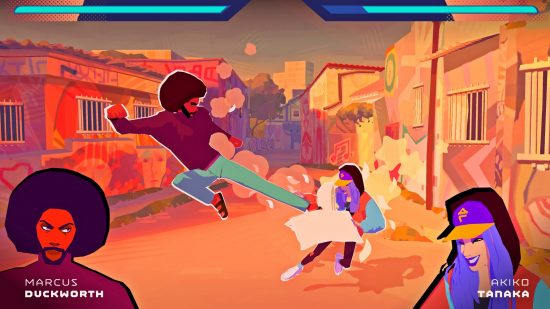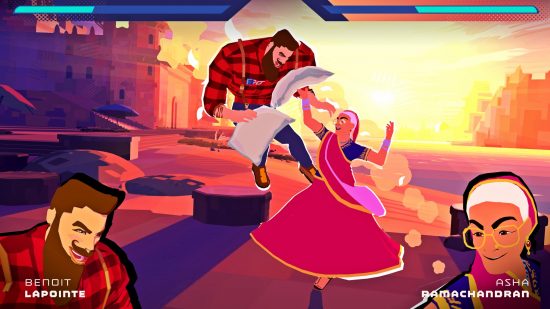Picture the scene: Two ordinary people are stuck in traffic. They’re tired, angry, and in desperate need to vent their frustrations. Instead of resorting to rude hand gestures, they arm themselves with pillows and duke it out on the highway until they return to their cars laughing. This sequence of events is patently absurd. It’s also the central premise of Pillow Champ, the next genre-bending fighting game from Frosty Pop. Ahead of its release, PCGamesN caught a preview of Pillow Champ and spoke to CEO Faisal Sethi and narrative designer Xalavier Nelson Jr. to wrap our heads around the not-so-deadly art of pillow combat.
“Most of society’s ills – family, war, hunger, poverty – have largely been eliminated by the invention of the Pillow Champ league,” Xalavier explains. This particular brand of world logic will be familiar to anyone versed in Xalavier’s own development label, Strange Scaffold. The notion of solving world peace with pillow-fighting is ridiculous, but it’s also sincere enough that you can’t help but buy into it – just as you can’t help but buy into the emotional interiority of stock photos of dogs in An Airport for Aliens Currently Run By Dogs.

The earnest silliness of Pillow Champ’s premise also imbues it with an approachability that invites an audience that would otherwise be too intimidated to engage with titanic, long-established fighting games like Street Fighter. Its simple, feather-stuffed twist also allows plenty of opportunities to riff on memorable fighting game moments that fans of the genre will recall fondly, such as Street Fighter’s car-smashing minigame – except this time around, attacking a car with a pillow only results in polishing it up. In Pillow Champ, destruction becomes restoration.
Of course, this overt pacifism is by design. Faisal credits his young daughter as a big motivation behind Pillow Champ’s development, allowing him to introduce her to the games he loved growing up (such as Karate Champ and Kung-Fu Master) in a slightly more child-friendly fashion. However, Pillow Champ’s family-friendly approach doesn’t relegate it to one particular age bracket. “It’s a fighting game that can be played by families but not necessarily a fighting game for families,” Xalavier clarifies.

Faisal likens Pillow Champ’s control system to Smash Bros, and the team has consulted professional fighting game players to help imbue Pillow Champ with the depth necessary to appeal to the genre’s core audience. It also encourages players to rely on tactics over invincibility frames. “The style of combat is much less combo-heavy; it’s not attempting to stun-lock your opponent,” Xalavier explains, which probably comes as a relief to anyone who’s been juggled to death in Mortal Kombat.
While Faisal considers the esports scene a secondary or tertiary audience, Frosty Pop has endeavored to outfit Pillow Champ with everything required to reach those competitive heights. Online multiplayer and skill-based matchmaking are a given, but rollback netcode is a truly welcome surprise from an indie studio – a feature that behemoth Bandai Namco is only just beginning to implement in Dragonball FighterZ.

Naturally, Pillow Champ’s combat is accompanied by a soundtrack that’s characterized by a pulsing beat and a playful synth that echoes the music of its 16-bit progenitors. It’s also inspired by the soundtracks for David Fincher’s The Social Network, as well as Night School Studio’s Oxenfree, lending it a sharp modern quality that makes for easy listening. Faisal also points to Sayonara Wild Hearts as inspiration for Pillow Champ’s bold use of color and shapes. These far-flung influences across multiple genres and mediums speak to Pillow Champ’s playful effervescence.
In terms of narrative design, Xalavier cites Mortal Kombat 11 and Injustice 2 as notable games that explore “very big, lore-driven worlds with deeply human stories” which helped dismantle his own prejudices toward fighting game narratives. To that end, two story modes will be available at launch, with more to follow. These initial stories provide contrasting perspectives within Pillow Champ’s world, charting the lives of above-board Pillow Champ League founder Marcus Duckworth and Akiko Tanaka, an accomplished member of an underground pillow-fighting subculture.
“I wouldn’t say that we deconstruct the tropes of fighting game storytelling,” Xalavier assures, “but we treat it with a humanity and dignity that ends up elevating the entire experience: real people, real emotions, real pillow-fighting.” Both Faisal and Xalavier impart the semi-autobiographical facets of these storylines, and they are strikingly poignant – from Xalavier’s first foray into mosh pits to Faisal’s memories of a childhood friend who passed away. “I didn’t want to make a parody of a fighting game,” Faisal says. “I wanted to make something sincere.”
Pillow Champ’s characters themselves are grounded in reality; from a nurse to a CEO to a librarian, the initial roster is comprised of eight ordinary people with ordinary problems, motivations, and emotions. It’s also strikingly diverse, fostering an inclusivity that encourages virtually anyone to see themselves represented in Pillow Champ’s world. While the very concept of pillow-fighting is inherently cross-cultural, Pillow Champ fighters express their culture through their movements, whether it’s Muay Thai, traditional dances, or yoga.
Equally, Pillow Champ avoids tokenism by adopting a holistic approach to character expression. “When you are depicting a world that includes a lot of representation, there can be a large pressure to have that representation voiced very overtly,” Xalavier explains. Instead, Pillow Champ eschews this reflex in favor of characters that prioritize what’s relevant to their lives, and their gender, race, and sexuality are only explored when it makes sense to do so. These characters exist as humans, rather than representational concepts, and Xalavier cites “the power of a team that is led by diverse people” that makes this possible.
It’s no secret that fighting game development typically comes with a hefty cost that can rapidly price out indies; fellow indie studio Lab Zero Games has resorted to crowdfunding the hundreds of thousands of dollars necessary to create additional characters in Skullgirls. Frosty Pop reconciles that exorbitant cost on an indie budget with a lean development team, a clearly defined scope, and long-term partnerships. While the likes of pillowcase skins are still a twinkle in Faisal’s eye, the promise of more characters and stories assures me that Frosty Pop’s feather-down utopia is looking fluffy and bright.
Pillow Champ is coming to PC on Steam, as well as Netflix Games and Nintendo Switch in Spring 2024. In the meantime, take a look at our top picks for the best indie games, along with more upcoming PC games to look forward to in the coming months.


